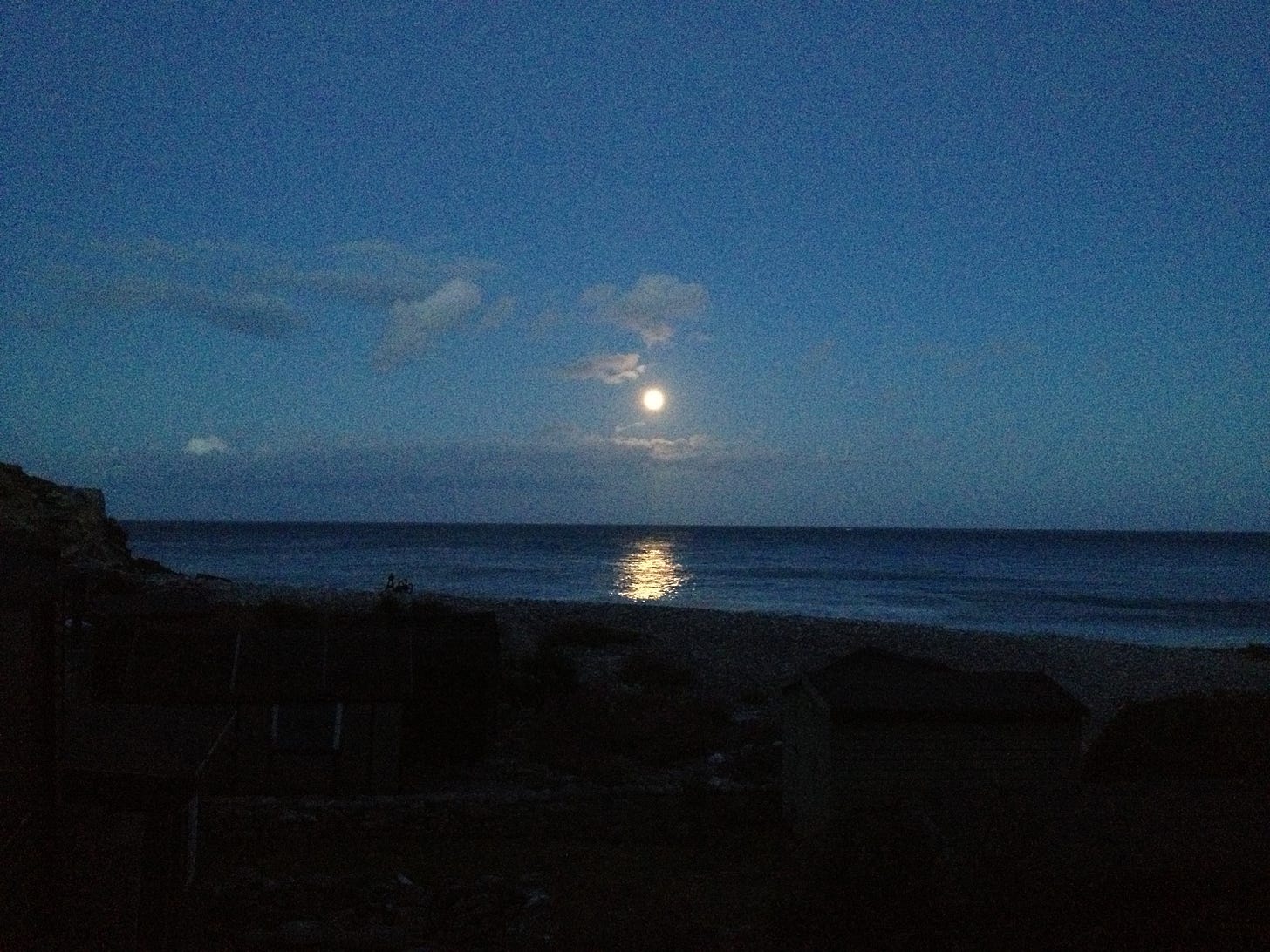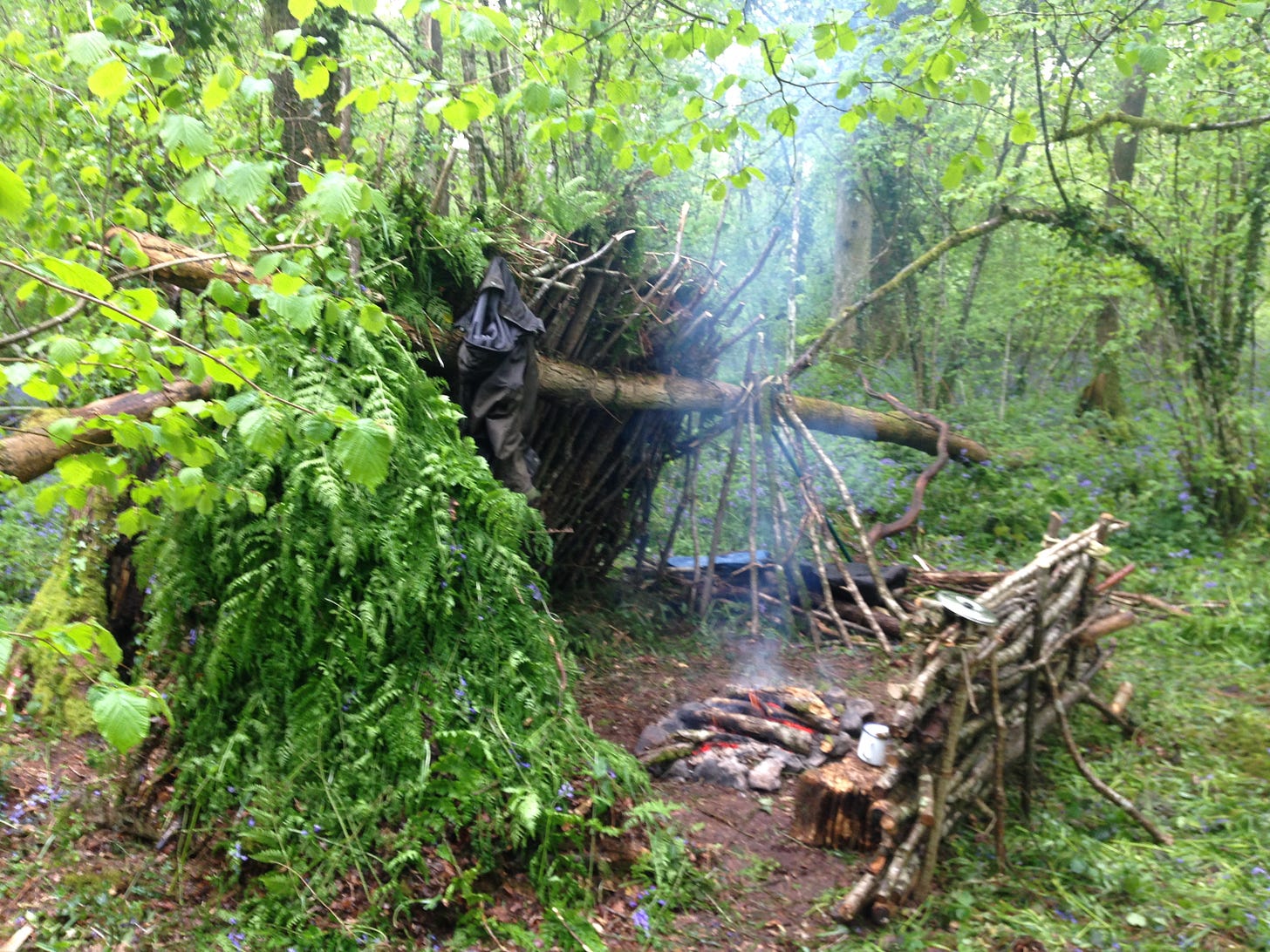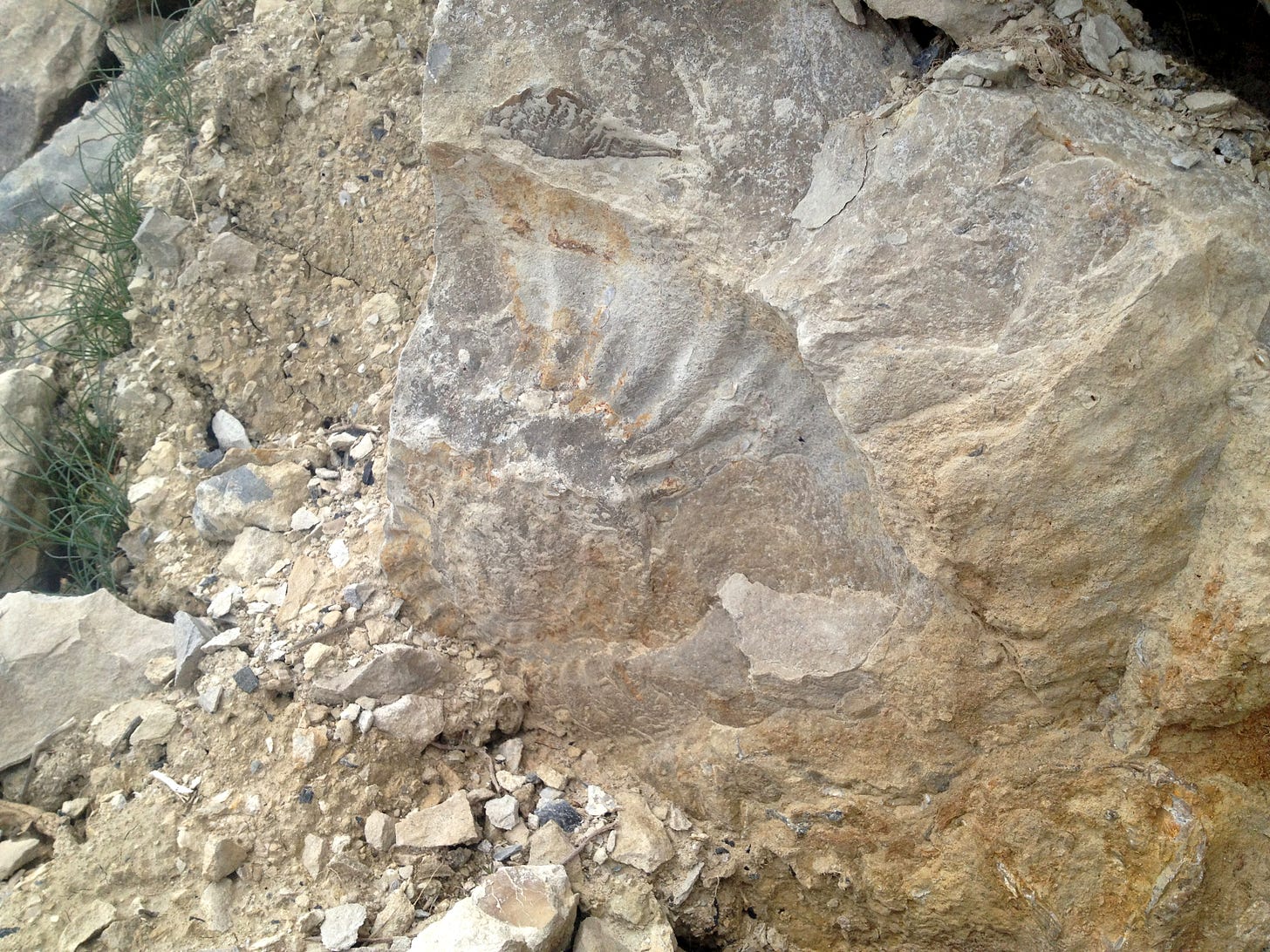April 2nd 2023
I am typing this just after packing to go to the bay I first wrote about online at Dark Mountain in 2018, when I made rock art for the cover of issue 13. I am also gently planning a pilgrimage to walk with two friends in a year or so to St Wite’s Spring, her church and reliquary in Whitchurch Canonicorum, and to Abbotsbury, on the Fleet, the site of the world’s largest tended flock of wild swans. Easter and Ostara blessings from the south coast of this archipelago.

Audio version
I no longer own beach huts at the cove, but dear ones still do. So I can go and rest my body amongst the rounded white rubble of the bones of my very long dead sea-ancestors, only 30 miles from my birthplace. 1
Limestone rock is animal rock, aquatic exoskeletal calcium, (I was told flint is the now glass-like, but once-seething, liquid innards). To sit there, on the Jurassic coast, and feel my mind washed by the swash and backwash of the waves, is to experience a pre-mammalian kinship. I love to rock-hop over ammonite fossils the size of tractor tyres. When I am inland, iron often has the upper hand - ochres call to me in sanguine reds and choleric yellows. But here, white gleams, as brightly as chalk, but denser, harder, and more secretive. If iron is the blood, and chalk the teeth of my mother the earth, then this limestone is her jaw bone. Today I am a little critter, nestled in her bleached maxilla, a mug of tea and laptop to hand, (happy anachronisms). Tomorrow I will be listening to the whisper of her voice in the offshore breeze, the bladderwrack smack and the rooks’ racket. Cove poetry. But today after I record this for you, I will process another 3 kilos of rock from the crumbled cove edge and turn it into pigment for Ground Bright. This will take me an hour by hand with pestle, mortar and sieve, and I shall gladly return to the now-time of the hand.
From ‘Walk out into the rocks’, 2018
I should tell you who I am, and what I think. But my opinions about anything are of little consequence: there are my connections and relationships, the things I do, and do not do.2 Every day I get to walk on the bright earth I am overjoyed. From the youngest age, the sea-edge was my constant companion, it's where people from my patch go when they have good news, bad news, or no news. All our first kisses are outdoors, first fumbles are under the pier. Nothing good ever happens without you getting sand in your pants or shoes or both. How you find your first boyfriend is on New Year's Eve around the clock tower in the square, like it was, back through the centuries, until they demolish it in your adulthood for traffic easing. This is the essential knowledge of any poor, arty, bookish, goth girls from our ends, (before the age of the internet), and there were quite a few of us, hence the Royal 'we'.
I will state the unpopular fact: the earth is alive and sacred. I always knew it and I know it again now, being mostly fully reclaimed from the grid-like grip of the machine. I don't have one cogent argument to offer in defence of my love of land. It's all feeling, which is why I can't be a politician, environmentalist or a writer, perhaps. I tend to stop mid-sentence to light a candle or make an offering. In Parliament, at meetings with one’s editor, and in stand-offs with the police this is not the done-thing. What can I offer?
These words, my movement and my life, in conversation with the earth.
The ancient yoga of Britain is walking, the pilgrimage. The ancient offering of these islands is conviviality in nature under the wild wood and stars. The wine of the land is spring water. Our altars are stones or wood set upright or recumbent. Reverence is raising love amongst family and friends, celebrating the turning of the year, the welcoming-in of strangers. Art, song and dance should be everywhere. It's a crime that they're not. It is equal parts Julian of Norwich and Julian Cope. It is eating large handfuls of cobb nuts fresh off the ground and beating the squirrels to them. It is also making sure another handful get planted, then tending the hazel trees as they grow, pollarding a few for bean poles and walking staffs. It is remembering to wassail them.
For years I researched my passions, studied with good teachers about early art materials, wilderness survival and earth skills; then made a bed, bower and fire, staying warm all night and sheltered from the rain, cooking on embers of hazel and bony oak. Oak bark made roofing tiles. In my bower as I lay there under the wild raw thatch, it became clear that the best postures for a human to meet the land are walking, externally, and wonder, inwardly. At the end of the day you can lie under your wool blanket on a bed of springy spruce boughs and wait, open.
Once, as I often did in those days, I rode the train over the great mouth of the River Tay at Dundee which takes 4 minutes to cross. The green-brown water was rolling under me and the water was flowing in two directions at once. The tide was coming in very strongly, flood tide. The river was full of winter rain flowing down to the sea, following its nature, and causing static waves that looked like the surface of flowstone in Cheddar caves, or like the skin of a great serpent. The wind was also whipping up small white caps on these standing waves. I saw all this with my eyes, but I felt it viscerally. The whole land pleased me so immensely: when I get held by whatever this earth energy is, it feels like this.
Over this entire archipelago, mountains in Ireland and the UK are not so high, even Ben Nevis can be walked in a day. There is no K2, no Ararat, or Eiger. Well-travelled sophisticates sneer at their own mellow lands and do not realise that the valley and the mountain are two parts of the same whole, an ineffable thing that cannot be reduced to spot heights above sea level on maps. The real land magic here is the vastly crenelated coastline. It is so long, going in and out of 100,000 inlets on over 1000 islands. The rivers and the sea are an embrace, you can’t be sleepy in such arms, they can suddenly squeeze you, and you may drown.
Explaining my love of land to people, I have tried sincere clarity, and well-made arguments, but I never won over anyone for earth that way. Instead I get people excited about mixing paints from cherry tree gum and deep red earths dug, washed and graded by Jonathan the Freeminer in the Forest of Dean, like his ancestors over the last 4400 years. Or by getting people to use their earwax to help mix a blue watercolour from indigo made from woad, and by boiling up oak gall ink from tree bits and rusty nails. If it doesn’t feel great in their body, they won’t care. Materials of earth foster love of land and its preservation.
On Portland, Dorset, I sleep overnight in a hut on the beach, listening to the roar of the spring tide on the pebbles. The cove where I stay has intriguingly shaped stones, which at closer inspection turn out to be sea-rounded quarry waste. The Weares themselves, the high cliffs and ragged, now protected, habitats along the coast, are full of lizards, raptors and tiny versions of wild flowers, happy in the ‘unimproved’ soil. This place is a fecund absence: the stone for St Paul’s Cathedral, Whitehall, The Cenotaph, and so much of what rebuilt official, religious and bureaucratic central London after the Great Fire was removed from here.3 You can still find huge blocks with Sir Christopher Wren’s sigil on, (an up-turned wine glass). To me this place itself is the uncivil inverse of the City of London, its exiled, wind-scoured, kestrel-eyed wild twin.
This week’s good thing: Here is a superb essay by artist and independent scholar
There is so much in this short piece, I urge you to read it, if only to begin to prise the head-mind's corpse-like grip off the heart-mind's understanding of what the hand, animated by spirit, can do.The 4 coastal pictures this week are from 2013. I can’t believe I’ve already spent a decade in love with this lively remnant crag, but I have.
Slartibartfast, crenellated coastline designer, extraordinaire.








'...it became clear that the best postures for a human to meet the land are walking, externally, and wonder, inwardly': yes!
I wish I could say something, but the writing is beautiful and I would only be interfering.